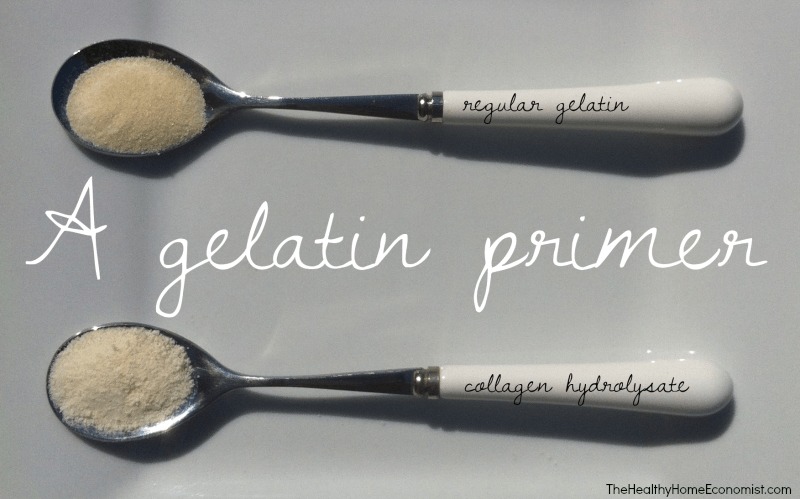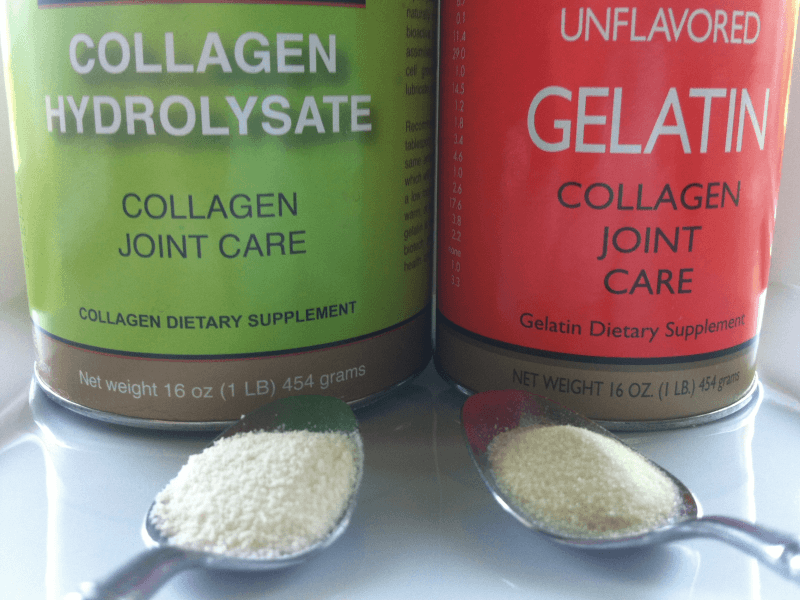The important differences between collagen hydrolysate (peptides) and gelatin, and a comparison of both to identify which one is better for anti-aging, cooking and overall health.

Gelatin (also known as cooked collagen) is a wonder food with anti-inflammatory and anti-aging qualities, as it helps to fill in the missing amino acids (the building blocks of proteins) in the standard American diet.
According to Ray Peat, Ph.D., “The degenerative and inflammatory diseases can often be corrected by the use of gelatin-rich foods” (1).
One of the greatest benefits of using gelatin is to help balance our amino acid intake. Because collagen makes up approximately 50% of the whole animal, gelatin can be used to help create a more complete protein balance in our diet. The standard American diet tends to be very high in muscle meats (such as beef, chicken, lamb, and turkey), which when not balanced by other proteins (such as eggs, fish, dairy, shellfish, organ meats) can contribute to inflammation over time (2).
The benefits of gelatin are many as it has a unique and very non-inflammatory amino acid profile, primarily consisting of glycine, glutamic acid, proline, and alanine (tryptophan and several other amino acids are completely missing).
Although these are non-essential amino acids (meaning your body can make them), many malnourished and over-stressed livers are not able to manufacture all the non-essential amino acids in the amounts demanded by the body. The liver needs an abundance of these proteins to keep functioning optimally, particularly to fuel phase 2 detoxification. This helps your body detox or “take out the trash” in our toxic world, reducing inflammation!
Gelatin versus Collagen Hydrolysate

Although the most nutrient-dense source of gelatin is homemade bone broth (since it contains minerals as well), powdered versions offer a more convenient way to consistently get it into your diet.
Processing
I spoke personally with the president of a company that produces collagen and gelatin to get the low down on exactly how collagen hydrolysate (also called hydrolyzed collagen) and gelatin are processed.
According to this reputable source, the company uses grass-fed beef hides for the raw material for their bovine products. The split hides (under the hair where the collagen lies) are put into an alkaline solution and held for a number of days where the material is broken down into smaller pieces of skin.
Next, it’s acid back washed and pumped into cooking kettles which separate tallow, skin, and collagen. The collagen is then filtered and put through a vacuum evaporator at 212 degrees F (a very delicate process). After evaporation is complete there is a four-second sanitation process at 240F degrees that kills any unwanted bacteria. At this stage, it is classified as pure collagen.
Collagen hydrolysate (quality sources): The collagen is stored in a holding tank at a higher temperature to reduce the molecular weight cleaving the amino acid bonds. This process is called hydrolysis. At the appropriate time, it is then introduced to the spray dryer whereas the product is made into a dry powder.
Gelatin (quality sources): The collagen is sent to a votator, chilled and solidified, pumped onto a drying belt, and is now considered gelatin. It is dried to under 12% moisture, milled to a granular specification and packaged.
How to Best Use Each Type of Collagen
Collagen hydrolysate – The hydrolysis process described above renders the gelatin powder more easily digestible and appropriate for those with digestive weakness and sensitivity. I find this type of gelatin best used as a protein powder with careful dosing (see Important Note below).
Mix collagen hydrolysate in drinks, shakes, smoothies, ice cream, or add a tablespoon to your favorite recipe to give it an anti-inflammatory protein boost. It will dissolve in cold liquids easily.
Having collagen hydrolysate with a meal that contains muscle meat can help balance the amino acid profile that enters your bloodstream. “If a person eats a large serving of meat, it’s probably helpful to have 5 or 10 grams of gelatin at approximately the same time, so that the amino acids enter the bloodstream in balance.” Ray Peat, PhD. (3)
Gelatin – Regular gelatin is only hot water-soluble and best used to create foods that gel (fruit snacks, healthy jello, homemade marshmallows, desserts, etc).
How Much Do You Need?
Individual needs will vary, but most people can start off with about ½ -1 tablespoon per day of collagen hydrolysate (either as powder or capsules), and increase by 1 tablespoon every two weeks or so as tolerated.
According to Ray Peat Ph.D., gelatin can make up about 30% of total protein intake, which for the typical person is about 3-6 TBL of gelatin per day (1 tablespoon of gelatin is 6 grams of protein).
Contraindications
Remember not to get too carried away with either gelatin or peptides. Adding too much too quickly can cause digestive issues: bloating, loss of appetite, stomach ache is just a few side effects.
It’s important to remember that more is not always better, especially if you are adding it to your diet for the first time.
Gelatin should be used in addition to a nutrient-dense diet and not to replace real food like homemade bone broths and grass-fed meats.
Where to Find the Best Collagen and Gelatin
Perfect Supplements and Radiant Life are the only two companies that currently offer a quality source of both collagen and gelatin that is gently manufactured and third-party tested/certified for purity (no glyphosate residue risk!).
These quality protein supplements blend easily into the beverage, smoothie, or food of your choice. Choose between grass-fed collagen, and gelatin both available in large, economical canisters.
Marine collagen is also an option for those fish-eating vegetarians.
This supplement is also available in very convenient Type II collagen capsules. This is a great option for traveling.
References
Great Lakes FAQ
Gelatin, stress, longevity by Ray Peat
More Information
The Reason You Need More Gelatin in Your Diet
5 Reasons Your Stock Won’t Gel
Bulletproof Coffee (even with added peptides) Shoots You in the Foot








I don’t yet eat animal proteins (trying to heal my gut a bit first in order to digest them better) but have recently started to use collagen. Is this ok to use without eating meat/eggs or will this case an amino acid imbalance? For someone not eating meat, do I need to eat more or less collagen?
Are there any side effects for someone in my scenario?
I have been taking Gelatin powder for 2 weeks. I instantly felt different, clearer vision, clearer mind and even noticed my skin had started to changed.
I read several sites regarding how to take gelatin, most of which recommended eating as much gelatin as possible. I was taking 2-3 tablespoons per day. After a few days, I started to noticed severe bloating!!! My stomach has taken on a full & uncomfortable shape (I did have a flat stomach before).
I don’t want to stop taking the gelatin (the benefits have been outstanding) but after reading your recomendations I think I just took too much too soon.
I have since reduced it to one teaspoon in the morning and one teaspoon before bed (3 days ago).
The bloating is still present.
Do you know how I can get rid of the bloating? I am only able to take the powdered form of gelatin, as I don’t have access to kitchen facilities to cook bone broth (I’m traveling!).
Thank you so much.
Hi, I was just wondering if you were ever able to tolerate the gelatin? I am having the same reaction…very severe bloating that has still not gone away after a week of not taking the gelatin. Thanks for any input.
I notice that those with very poor digestion do not tolerate gelatin well (either form) and that it’s necessary to up-regulate your digestion first, and THEN introduce it. You can read more about this here –> http://butternutrition.com/what-you-dont-know-about-gelatin-may-hurt-you-5-things-you-need-to-know/
Abundantly,
Catherine
yeah regular gelatin makes me nauseous… I want to try the hydrolysate kind maybe that will work for me.
Just an update, I tolerate the collagen hydrolysate just fine!
Aloha Catherine, I’m trying to sign up for your news letter and the button under where I place my email just goes straight to mail chimp.
Thank you for the great info. 🙂
Hi SuniRae,
You can subscribe to my newsletter here: http://eepurl.com/qGdrL
Thanks for reading!
You mentioned in the article that the “The collagen is stored in a holding tank at a higher temperature to reduce the molecular weight cleaving the amino acid bonds,” is there any chance that you know what is being cleaved from the collagen? I.e. the amino acid bond. What I mean is that if a a bond is being separated, with the collagen still in tact, won’t there be something that is being lost/left behind?
Does anyone know of an organic source of gelatin?thank you(:
I think that homemade organic bone broths are some of the richest sources of gelatin. My family has made a chicken broth from a whole chicken before (neck and feet not intact) and it was very fragrant and tasty, for the exception of being very greasy, which I’m guessing is a side effect of the natural oils and fats from the bones, skin and meat. But I found this site that might address the issue of the broth being too oily or cloudy: http://chowhound.chow.com/topics/275309 —-The comments are especially helpful. 🙂
P.S. You can also try beef, bison or lamb in your homemade stocks. I hear they are just as good.
Also…
I most definitely prefer bone broths as my source of gelatin, but I read that head cheese, pig’s feet and ox tails are also good sources of gelatin. So whatever you think would work best for you. 🙂 Well, hope that helped. 🙂
Hi, Could anyone advise me on what to do with my bone stock I just simmered for 20 hours, only to find a piece of saran wrap from the packaging when straining the stock, which simmered with the bones the entire time? Would you toss the stock? Thanks so much for any replies.
was the piece of saran wrap altered or melted during cooking?
I’ve read that gelatin is contraindicated for herpes sufferers because of the arginine to lysine imbalance. Do you know if the same is true for collagen hydrolysate? I have not been able to find any statistics. Thanks.
My husband and I have been consuming the collagen hydrolystate for about 6 months and he, a herpes sufferer, has not had a breakout since. Not saying it cured it, but it definitely hasn’t caused more breakouts. Hope this helps.
Thanks Sherry. I tried the collagen hydrolysate this winter. I worked the dose of up slowly and by the time I got to 1 TBS per day, I had an outbreak. Could have been a coincidence so I backed off for a week and tried again. I ended up with three outbreaks inside of about six to eight weeks. In looking at the nutritional facts on the canister, if I take a 500 mg of lysine with each TSB of CH, that should balance the lysine to arginine though I haven’t been brave enough to test it out yet.
Go to the Great Lakes or Vital Proteins websites. I mention these two companies as they are the only companies I know of selling grass-fed, pastured gelatin. Both companies list the exact amino acid breakdown of their products from which you can determine the arginine to lysine ratio of each of their products. Hopefully this helps you troubleshoot your issue.